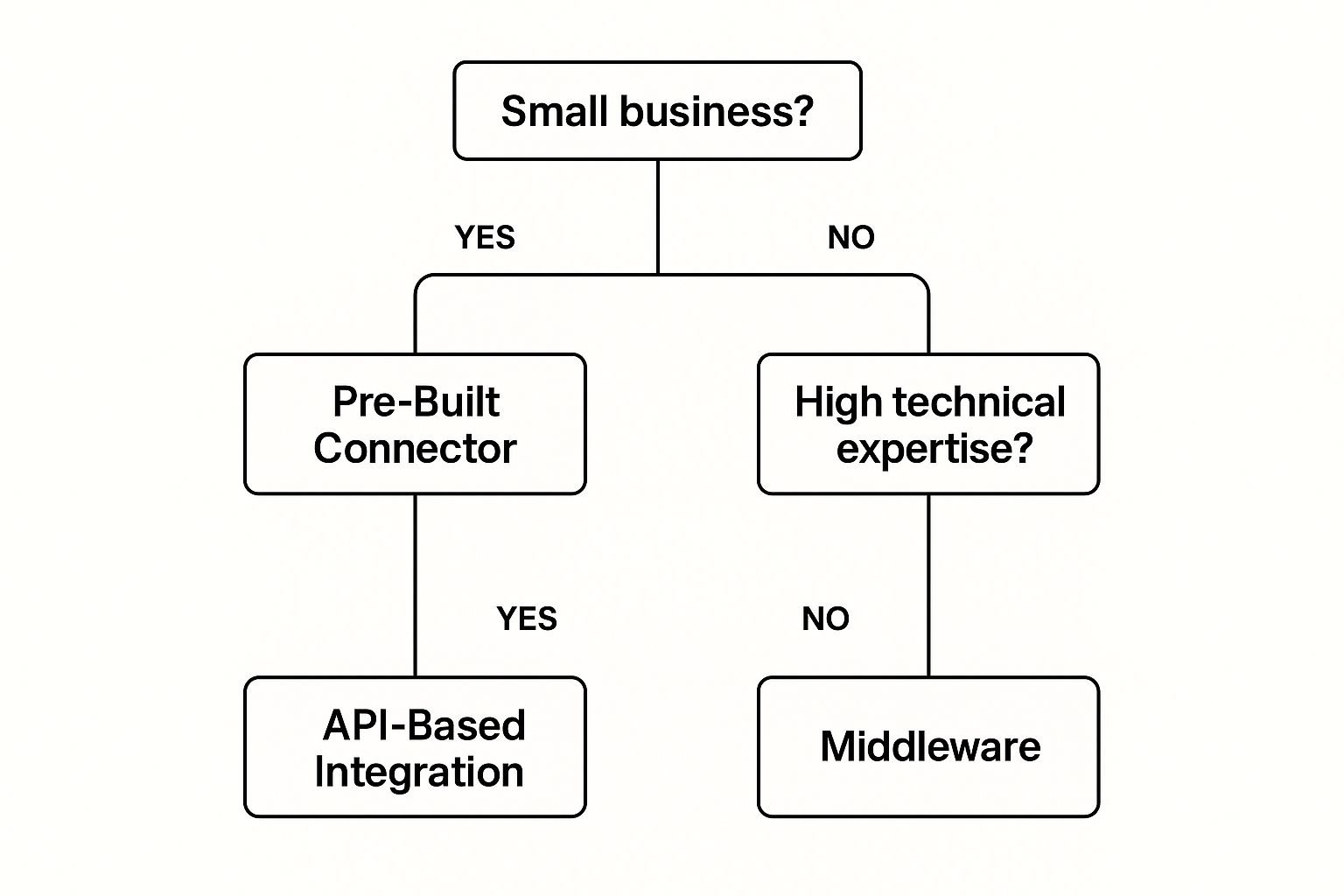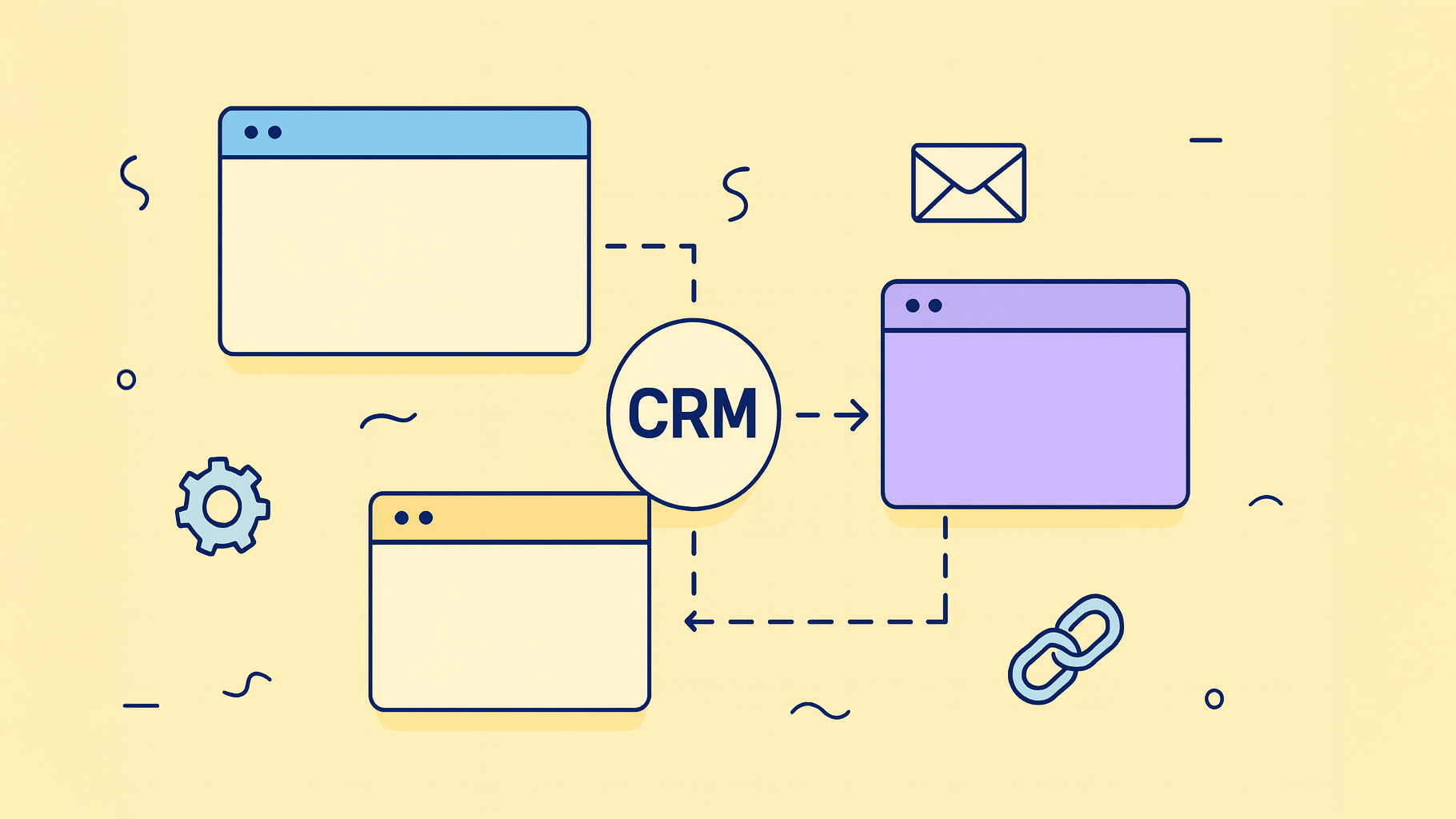CRM integration is all about connecting your Customer Relationship Management (CRM) software to the other tools you use to run your business, creating a single, unified system. Think of it as building a central nervous system for your company. It ensures that your sales, marketing, support, and even finance applications are all speaking the same language and sharing information in real time.
So, What Is CRM Integration in Simple Terms?

Let’s try an analogy. Imagine your business departments are a group of all-star employees. They’re fantastic at their individual jobs, but there’s a catch: they never speak to each other. Your sales team has crucial notes from client calls, marketing knows exactly which campaigns a customer clicked on, and finance has the full payment history.
Without a way to connect these pockets of knowledge, everyone is working with an incomplete picture of the customer. This is exactly the problem that CRM integration solves.
Tearing Down the Data Silos
At its heart, CRM integration is the strategic move to tear down these communication barriers, often called “data silos.” It’s less about wrestling with complex code and more about building smart, digital bridges between the applications your teams live in every day. The process connects all these separate systems to your central CRM, which becomes the undisputed single source of truth for all things customer-related.
The whole point is to create a seamless, two-way flow of data. For example, when a support agent resolves a ticket in their helpdesk software, that update should automatically pop up on the customer’s profile in the CRM for the sales team to see. This bi-directional sync gets rid of mind-numbing manual data entry and, more importantly, makes sure everyone is on the same page.
A unified CRM is the hub that connects various business functions, ensuring data flows freely between them. This creates a more cohesive and efficient operation where every team has the context they need.
The table below breaks down the core components that are typically linked together.
Core Components of a Unified CRM System
| Integrated System | Primary Benefit |
|---|---|
| Marketing Automation | Personalize campaigns based on sales and support history. |
| Sales Tools | Access complete customer journey for tailored pitches. |
| Customer Support Desk | View sales history to provide contextual, proactive support. |
| E-commerce Platform | See purchase history directly in the customer profile. |
| Financial/ERP Software | Automate invoicing and view payment status in the CRM. |
| Project Management | Link customer issues or requests to development tasks. |
By connecting these systems, you don’t just share data—you create a smarter, more responsive business.
Creating a 360-Degree Customer View
Ultimately, the real power of CRM integration is its ability to give you a complete, 360-degree view of every single customer interaction. This unified perspective is priceless.
By connecting Customer Relationship Management (CRM) software with other business applications, you ensure seamless data flow and unified workflows. This enables businesses to access customer information, sales data, and support interactions all in one place. You can discover more CRM statistics and see their impact on business growth.
This all-around view empowers your teams to make smarter decisions, faster. A salesperson can tailor their pitch based on a recent support issue. A marketer can build hyper-personalized campaigns based on purchase history. And a support specialist can offer proactive help because they understand a customer’s entire journey with your company, from the very first touchpoint.
Why Disconnected Systems Hurt Your Growth

When your business tools don’t talk to each other, it’s more than just a minor headache—it’s a genuine anchor dragging down your growth. Think of it like a relay race where the runners never manage to pass the baton. That’s what happens with disconnected systems. Each department ends up running its own race, totally blind to what the others are doing.
This creates all sorts of messes. For example, your sales team might have no idea that a high-value prospect just logged three urgent support tickets. They pick up the phone to make a sales call at the absolute worst moment, torpedoing the relationship and killing a potential deal. This isn’t some rare fluke; it’s the daily reality when your teams are working in silos.
The Hidden Costs of Data Silos
Disconnected data introduces friction at every single touchpoint. The result? Wasted time, frustrated employees, and confused customers. These costs pile up fast, often in ways that don’t show up neatly on a balance sheet.
You start seeing common problems crop up:
- Endless Manual Data Entry: Your people spend hours every week just copying and pasting information from one system to another. It’s not only mind-numbingly dull but also a recipe for human error.
- Incomplete Customer Views: Support agents are talking to customers without knowing their purchase history or lifetime value, completely missing chances to provide personalized service or spot an upsell opportunity.
- Misaligned Teams: Marketing launches a brilliant campaign that brings in great leads, but the sales team has zero context on how those leads were nurtured. They’re left with generic, ineffective follow-ups.
This lack of a single, unified view hits your bottom line directly. Every duplicated task, every poorly informed conversation, and every missed opportunity is a real, tangible loss. In this context, CRM integration isn’t just some tech upgrade; it’s a fundamental piece of the puzzle for sustainable growth.
From Inefficiency to Opportunity
The difference between a siloed nightmare and a fully integrated ecosystem is night and day. When your systems are connected, information flows freely, empowering every single team to do its best work. A support ticket logged in your helpdesk automatically pops up in the CRM, giving the account manager a heads-up. A big deal closed by sales can kick off a perfectly tailored onboarding sequence from your marketing automation platform.
This shift—from jumbled, scattered data to a single source of truth—is where businesses unlock massive performance gains. Breaking down these silos is directly tied to higher revenue, faster operations, and happier customers who actually stick around.
The numbers don’t lie. The impact of connecting your CRM to other tools is undeniable. Businesses that implement CRM integration see an average sales increase of 29% and sales cycles that are 34% shorter. What’s more, linking the CRM with support and marketing platforms can boost customer retention by 24% and increase sales team productivity by 34%. You can dig into the market research on CRM performance to see the full data for yourself.
At the end of the day, disconnected systems force you to run your business with blinders on. A proper integration strategy takes them off, giving you the clarity you need to not only keep your customers but also to scale your entire operation effectively.
Choosing Your CRM Integration Approach
Not all integration projects are created equal, and picking the right method is make-or-break for your success. The path you take really boils down to your team’s technical chops, your budget, and just how much custom tailoring you need. Getting a handle on the main approaches will help you make a call that serves you well in the long run.
Think of it this way: each integration type strikes a different balance between convenience and control. Some are simple plug-and-play solutions, while others need expert developers to build them from the ground up. Let’s break down the three primary options.
Native or Pre-Built Integrations
The simplest path is a native integration. These are ready-to-go connectors, often built by the software companies themselves. A great example is a CRM provider offering a direct, one-click integration with a popular email marketing tool.
- Analogy: This is like using Apple’s own apps together, such as Messages and Contacts. They’re designed from the get-go to work together flawlessly with almost zero setup.
- Best For: Teams that need a quick, reliable, and low-cost way to connect common, mainstream apps without any technical heavy lifting.
Third-Party Middleware Connectors
Next up, you’ve got third-party middleware tools. These platforms act as a bridge, connecting thousands of different apps that don’t have native integrations with each other. They’re powerful and flexible, often letting you build out more advanced automated workflows.
- Analogy: Middleware is like a universal translator. It allows two people who speak different languages (or two apps with different APIs) to communicate without either one having to learn the other’s language.
- Best For: Businesses that need to connect a whole bunch of different systems and create complex, multi-step automated workflows that go way beyond what a simple native integration can do.
Custom API Integrations
Finally, the most powerful—and complex—option is building a custom API integration. This means hiring developers to write code that connects your systems exactly to your unique specifications. It offers limitless possibilities, but it’s a major investment of time, money, and technical expertise.
A custom integration is like hiring an architect to design and build a custom bridge between two buildings. It’s tailored perfectly to your needs, but it’s a major construction project with corresponding costs and complexity.
This infographic can help you visualize which approach might be the right fit for your organization, depending on your size and in-house technical know-how.

As the decision tree shows, smaller businesses with less technical expertise often do great with pre-built connectors. On the other hand, large enterprises with very specific needs might find that they have to go the custom API route.
When you’re shuffling sensitive data between these connected systems, it’s also critical to keep compliance in mind. You can learn more about how to navigate those rules in our detailed guide on building a GDPR-compliant CRM sync.
Real-World CRM Integration Examples
Knowing what CRM integration is in theory is one thing. But seeing it in action? That’s when the lightbulb really goes on. These connections aren’t just about moving data around; they solve real, everyday headaches and create tangible value for your company and your customers.
Let’s ditch the abstract and look at how these integrations actually work in a few common business scenarios. Think of it as connecting your core platforms to create a smooth, automated flow of information that lets your teams work smarter, not harder.
E-commerce and CRM Integration
Take a popular e-commerce platform like Shopify. When a customer buys something, that event is so much more than a single transaction. Without an integration, all that juicy data—what they bought, how much they spent, when they purchased—is stuck inside Shopify. Your sales and marketing teams are completely in the dark.
A direct integration with your CRM changes the entire game.
- The Problem It Solves: Sales and marketing have zero visibility into customer purchase history. This leads to generic, “spray and pray” marketing and completely missed upsell opportunities.
- The Integrated Solution: Every new Shopify order automatically creates or updates a customer’s profile in the CRM. Their complete purchase history, total spend, and even abandoned cart details are synced over.
- The Measurable Value: Now, your marketing team can build hyper-personalized campaigns based on what people actually buy, which is a surefire way to boost engagement and repeat business. Sales reps can see a customer’s lifetime value before they even pick up the phone, making for much smarter conversations.
This seamless data flow turns your CRM from a simple address book into a powerful hub for truly understanding customer behavior.
To give you a better idea of how this plays out across an organization, here’s a quick look at some common integration scenarios.
| Department | Integrated Systems | Key Outcome |
|---|---|---|
| Sales | CRM + LinkedIn Sales Navigator | Reps get enriched lead data and conversation starters right within the CRM. |
| Marketing | CRM + Marketing Automation (e.g., Mailchimp) | Personalized email campaigns triggered by customer behavior logged in the CRM. |
| Finance | CRM + Accounting Software (e.g., QuickBooks) | Automated invoicing and payment tracking, giving sales teams visibility on account status. |
| Customer Support | CRM + Helpdesk (e.g., Zendesk) | Support agents see full customer history, turning service calls into relationship-building opportunities. |
| Product | CRM + Project Management (e.g., Jira) | Development teams can prioritize bug fixes and features based on the number of affected customers. |
As you can see, connecting the dots between departments creates a much more cohesive and intelligent way of operating.
Helpdesk and CRM Integration
Now, let’s head over to customer support. Your team probably lives in a dedicated helpdesk tool like Zendesk to manage tickets and solve problems. But when an agent opens a ticket, what do they really know about the person on the other end? Is this a brand-new lead, a VIP client, or someone who just had a rough sales experience last week?
An integration between your helpdesk and CRM gives your support agents the complete customer context they need. This transforms them from reactive problem-solvers into proactive relationship-builders.
This connection puts crucial information right where your team works, empowering them to deliver a far better experience.
Marketing Automation and CRM Integration
Finally, think about your marketing automation platform, like Mailchimp. It’s fantastic for sending newsletters and nurturing leads. But for it to be truly effective, it needs to know who to talk to and when. It needs intelligence.
Connecting Mailchimp to your CRM creates a dynamic, two-way street for information. New leads from a webinar sign-up form can be instantly zapped into the CRM for a sales rep to follow up.
Even more importantly, customer data from the CRM—like their deal stage or recent support tickets—can be used to build smart segments in Mailchimp. This means a customer who just had a support issue resolved won’t get a generic sales promotion the very next day. This kind of coordination is what prevents awkward missteps and builds genuine customer trust.
Connecting Sales and Development with HubSpot for Jira
One of the most painful, yet common, disconnects in any growing company happens right at the border between the sales and product development teams. This gap often feels like a deep canyon.
Sales teams, living in a CRM like HubSpot, promise features and track customer bug reports. The problem? They have zero visibility once those requests enter the black box of a development tool like Jira.
On the other side of the canyon, developers in Jira see a long list of tasks and bug reports. They might see what needs to be fixed, but they’re completely missing the why. Is this bug affecting a single small account, or is it a showstopper for a massive enterprise client on the verge of churning? Without that insight, they’re forced to prioritize work with blinders on, which can lead to costly mistakes.
This siloed approach creates a slow, frustrating cycle for everyone involved—especially the customer who’s just waiting for a fix. This is where a high-value, specific what is crm integration solution becomes a real strategic advantage. It’s not just about connecting two platforms; it’s about getting entire departments aligned around the same goal.
Bridging the Gap with a Two-Way Street
A dedicated connector like the HubSpot for Jira integration by resolution Reichert transforms this broken workflow into a seamless, two-way street of information. It embeds critical HubSpot data—like customer details, deal size, and support tickets—directly within Jira issues. Suddenly, developers have immediate access to the customer context they’ve been missing all along.
This screenshot shows exactly how HubSpot customer data can pop up right inside a Jira issue, giving development teams instant context.
The integration means a developer can see in a flash if a bug report is linked to a high-value deal, helping them prioritize their work far more effectively.
But the connection works both ways. When a developer updates the status of an issue in Jira, that change is automatically reflected back in HubSpot. This gives the sales or support rep real-time visibility without ever having to leave their CRM. They can confidently update customers on progress, which builds trust and gets issues solved faster.
This isn’t just a technical connection; it’s a strategic tool for aligning the entire company. When sales can see development progress and developers understand customer impact, the business moves faster and delivers a better product.
The benefits of this specific integration are clear and direct:
- Accelerated Resolution: Developers can prioritize tasks based on real business impact, like deal size or customer tier.
- Improved Collaboration: Comments and updates are synced, so sales and development teams can communicate directly on an issue across platforms.
- A Single Source of Truth: Everyone works from the same, up-to-date information, which kills confusion and ends the manual data chase.
By implementing such a focused integration, you can also automate complex cross-platform workflows. To see how this works in practice, you can learn more about creating powerful HubSpot workflow triggers for Jira to automate communication and task creation between your teams.
Your Framework for a Successful Integration

Even the most brilliant integration strategy will fall flat without a solid plan to bring it to life. A successful project is about more than just plugging two systems together; it needs a clear framework to guide you from start to finish. This is how you sidestep common traps like scope creep and poor user adoption.
Think of it as building a house. You wouldn’t just start hammering away without a detailed blueprint, and the same logic applies here. A good framework ensures your CRM integration project actually delivers a measurable return.
Define Clear Business Goals First
Before anyone touches a line of code, you have to define what success looks like in plain business terms. Don’t just aim to “connect HubSpot and Jira.” That’s a task, not a goal.
Instead, aim for something concrete, like, “Cut the time it takes for sales to get an update on a customer bug report by 50%.” See the difference? These clear, measurable objectives keep the project focused and prevent it from spiraling out of control. They become the north star for every decision you make.
Map and Cleanse Your Data
Next up, you need to map out exactly what data is going to move between your systems. What information is absolutely critical for your sales team in their day-to-day? What specific details do your developers need to see from the CRM? Documenting this data flow is the only way to prevent chaos down the line.
A common and costly mistake is migrating messy data. An integration will only amplify existing data quality issues, so it’s critical to perform a thorough data cleanup before you connect anything.
Taking this step ensures you’re building on a solid foundation, not a house of cards. For a deeper dive, check out our guide to effective CRM data management.
Here’s an actionable checklist to keep your project on track:
- Set Specific Business Objectives: Go beyond the technical “what” and define the tangible business “why.”
- Map All Data Flows: Visually chart out which data fields need to sync between which tools. Don’t let anything fall through the cracks.
- Perform a Pre-Integration Data Audit: Hunt down and fix duplicate records, outdated information, and incomplete entries in your source systems.
- Plan for Team Training: Get your users excited and prepared. Schedule training sessions well before launch to get their buy-in and make sure they hit the ground running.
- Start with a Pilot Group: Test the integration with a small, hand-picked group of users. This lets you iron out any kinks before a company-wide rollout.
Following this framework turns a complex technical project into a manageable process that’s laser-focused on delivering real business value.
Frequently Asked Questions About CRM Integration
When you start digging into CRM integration, a few questions always pop up. It’s smart to get these answered upfront. Knowing the real story on cost, timelines, and potential headaches helps you walk into a project with your eyes wide open.
Getting the right answers gives you the confidence to pull the trigger.
How Much Does CRM Integration Typically Cost?
The price tag on CRM integration can swing wildly depending on how you tackle it. On one end, you have simple, native integrations. These are often cheap or even free, baked right into your software subscriptions. They’re a great, budget-friendly way to connect major, well-known applications.
Then you have third-party middleware platforms. These tools offer a lot more power and flexibility, but they come with a monthly fee. You could be looking at anything from under $100 a month to several thousand, all depending on how much data you’re pushing and how complex your workflows are.
The biggest investment, by far, is custom API development. A custom job can run from a few thousand dollars to over $50,000, not to mention the ongoing costs for keeping it maintained and updated. The trade-off? You get total control and a solution built exactly for your needs.
How Long Does a CRM Integration Project Take?
Just like cost, the timeline is all about complexity. A basic, out-of-the-box native connection? You could have that humming along in a few hours or, at most, a couple of days.
If you go the middleware route, you should plan for a few weeks. That gives you enough time to get the configuration right, map all your data fields properly, and run some serious tests to make sure everything works as expected.
Custom API work is the long game. These projects can easily take anywhere from one to six months—sometimes even longer if you’re connecting a whole bunch of complicated systems.
What Are the Biggest Risks of Poor Integration?
A botched integration can cause some serious pain, and most of it is data-related. Think corrupted, duplicated, or just plain lost information. When your data is a mess, you start making bad business decisions and people stop trusting the very systems you’ve put in place.
Another huge problem is creating clunky, inefficient workflows. If the new process is a nightmare to use, your team will just ignore it, and your adoption rates will plummet.
And you can’t forget security. A poorly built integration can be like leaving a back door wide open, exposing sensitive customer data and putting your company’s reputation on the line.
Ready to close the gap between your sales and development teams? The resolution Reichert HubSpot for Jira app builds a seamless, two-way bridge that gets your whole organization on the same page. Give your teams the full customer context they need to make smarter decisions.
